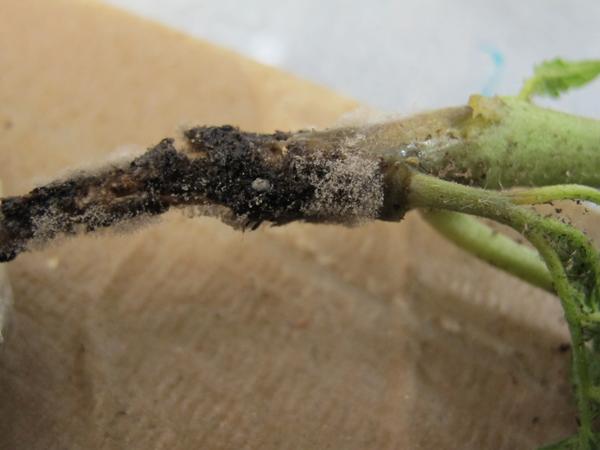Pathogen
Botrytis gray mold is caused by the ubiquitous asexual fungus Botrytis cinerea (B. cinerea).
Host Crops and Plants
Botrytis affects many vegetable crops including tomato, pepper, bean, potato, onion, crucifers, and cucurbits as well as fruits, berries, and ornamentals.
Host Parts Affected
Botrytis can affect all aboveground plant parts of tomato in both the greenhouse and field. This fungus occurs as both a pathogen and a saprophyte causing diseases such as damping off, stem girdling, foliar blighting, and postharvest rots.
Identification
Botrytis produces a dense velvety gray brown spore mass on infected tissue which when disturbed releases a cloud of spores (Figure 1). Tomato leaf and stem lesions are tan to brown in color. Stem infections occur during periods of high humidity through leaf scars, cracks, and pruning wounds. Spores can remain dormant for up to 12 weeks within pruning leaf scars and are triggered to germinate during plant stress. Stem lesions may expand in concentric rings to girdle the entire stem causing wilting above the infection site. Flower petals are very susceptible and can initiate infection of pedicels and developing fruit. Fruit lesions are typically a whitish soft rot and often the skin ruptures near the center of the decayed area allowing spores to form on exposed tissue (Figure 2). Small 3-8 mm whitish rings on the fruit surface are aborted botrytis infections known as ghost spots which reduce market quality.
Favorable Environmental Conditions for the Disease
- High humidity and moisture (4-6 hours of free water from dew, rain, overhead irrigation or greenhouse condensation is sufficient for infection).
- Cool to moderate temperatures (optimum growth 65-73°F).
- In North Carolina Botrytis typically occurs after midseason in the field and during postharvest shipping. The disease can occur year round in greenhouse production.
Disease Transmission
Pathogen spores are transported via wind, rain and greenhouse air currents. The fungus survives/overwinters as mycelia or sclerotia in plant debris and organic soil matter. Various other crops nearby may serve as pathogen sources. Fallen flowers are a common source of leaf infections.
General Disease Management
- Currently there are no known B. cinerea resistant tomato cultivars
- Apply fungicides preventatively prior to dense canopy growth, rotate fungicides to manage resistance
- Avoid overhead irrigation, minimize plant wetness
- Do not work on wet plants, prune plants in the early afternoon allowing wounds to dry quickly
- Ventilate greenhouses to maintain relative humidity at less than 90%
- Temperatures above 70°F discourage Botrytis development
- Practice good greenhouse sanitation, scout, bag, and remove infected plants
Disease Control for Conventional Growers
Botrytis gray mold of tomato can be controlled by using cultural practices, however, if disease pressure is high, fungicide sprays may be helpful to control disease. For the latest fungicide recommendations for gray mold see the Southeastern US Vegetable Crop Handbook. Fungicide labels are legal documents, always read and follow fungicide labels.
| Active ingredient | Example product | Pre-harvest Interval (day) | Fungicide group |
|---|---|---|---|
| Boscalid | Endura | 0 | 7 |
| Chlorothalonil + cymoxanil | Ariston | 3 | M + 27 |
| Difenoconazole + cyprodinilG | Inspire Super 2.09SC | 0 | 3 + 9 |
| Fluxapyroxad + pyraclostrobin | Priaxor | 0 | 7 + 11 |
| Potassium phosphite + chlorothalonil | Catamaran | 0 | 33 + M |
| DicloranG | Botran | 10 | 14 |
| Chlorothalonil | Bravo | 0 | M |
| G Can be used in greenhouses, see label for restrictions | |||
Disease Control for Organic Growers
Gray mold can be successfully controlled using cultural practices as listed above.
Disease Control for Home Gardeners
Gray mold can be successfully controlled using cultural practices as listed above.
Useful Resources
- The NC State University Plant Disease and Insect Clinic provides diagnostics and control recommendations
- The Extension Plant Pathology Portal provides information on crop disease management
- The Southeastern US Vegetable Crop Handbook provides information on vegetable disease management
- The USDA Fungus-Host Distributions Database provides information about reported hosts for fungal and oomycete pathogens
Acknowledgements
This factsheet was prepared by the NC State University Vegetable Pathology Lab in 2015.
Publication date: March 6, 2018
Reviewed/Revised: Jan. 9, 2023
Recommendations for the use of agricultural chemicals are included in this publication as a convenience to the reader. The use of brand names and any mention or listing of commercial products or services in this publication does not imply endorsement by NC State University or N.C. A&T State University nor discrimination against similar products or services not mentioned. Individuals who use agricultural chemicals are responsible for ensuring that the intended use complies with current regulations and conforms to the product label. Be sure to obtain current information about usage regulations and examine a current product label before applying any chemical. For assistance, contact your local N.C. Cooperative Extension county center.
N.C. Cooperative Extension prohibits discrimination and harassment regardless of age, color, disability, family and marital status, gender identity, national origin, political beliefs, race, religion, sex (including pregnancy), sexual orientation and veteran status.


